Utilization of an Automatic Tool for Building Material Selection by Integrating Life Cycle Sustainability Assessment in the Early Design Stages in BIM
Abstract
:1. Introduction
- RQ1: Is it possible to conduct an automatic calculation of the environmental, economic, and social impacts based on the LCSA method in real time using specific (improving the usability and data visualization) software integrated into the BIM environment?
- RQ2: Is it possible to implement an automatic multi-model assessment to support the building material selection within the BIM environment?
2. Materials and Methods
2.1. LCSA Implementation in BIM
2.2. Case Study Description
2.3. Tool Development
3. Results
Validation of the Tool in the Case Study Application
4. Discussion
4.1. Lessons Learnt from the Tool Development
4.2. Limitations and Future Developments
5. Conclusions
Author Contributions
Funding
Data Availability Statement
Acknowledgments
Conflicts of Interest
Abbreviations
| AHP | Analytic Hierarchy Process |
| API | Application Programming Interface |
| BIM | Building Information Modelling |
| DGNB | German Sustainable Building Council |
| EMVISESA | Empresa Municipal de Vivienda, Suelo y Equipamiento de Sevilla, S.A. |
| EPD | Environmental Product Declaration |
| IFC | Industry Foundation Classes |
| GBRS | Green Building Rating System |
| LCA | Life Cycle Assessment |
| LCI | Life Cycle Inventory |
| LCSA | Life Cycle Sustainability Assessment |
| LCC | Life Cycle Costing |
| LOD | Level Of Development |
| GIS | Geographic Information System |
| GUI | Graphic User Interface |
| GWP | Global Warming Potential |
| S-LCA | Social Life Cycle Assessment |
| TBL | Triple Bottom Line |
| TOPSIS | Technique for Order of Preference by Similarity to Ideal Solution |
| WinForms | Windows Form |
References
- IEA. International Energy Agency (IEA) Global Status Report for Buildings and Construction 2019; IEA: Paris, France, 2019. [Google Scholar]
- European Commission. European Commission COM(2011) 571 Final; European Commission: Brussels, Belgium, 2011. [Google Scholar]
- Alwan, Z.; Jones, P.; Holgate, P. Strategic sustainable development in the UK construction industry, through the framework for strategic sustainable development, using Building Information Modelling. J. Clean. Prod. 2017, 140, 349–358. [Google Scholar] [CrossRef]
- Mc Graw-Hill construction World Green Building Trends. 2013. Available online: https://sftool.gov/Content/attachments/World_Green_Building_Trends_SmartMarket_Report_2013.pdf (accessed on 1 November 2022).
- Parker, J. The Value of BREEAM, A BSRIA Report; BSRIA: Bracknell, UK, 2012; Available online: https://www.bsria.com/doc/rMwG2D (accessed on 1 November 2022).
- World Green Building Council. The Business Case for Green Building; World Green Building Council: Toronto, ON, Canada, 2013. [Google Scholar]
- UN—United Nations. The Sustainable Development Goals Report 2019; United Nations: New York, NY, USA, 2019. [Google Scholar]
- European Commission. European Parliament The European Green Deal. Eur. Comm. 2019. Available online: https://commission.europa.eu/strategy-and-policy/priorities-2019-2024/european-green-deal_en (accessed on 1 November 2022).
- European Commission. Circular Economy Action Plan; European Commission: Brussels, Belgium, 2020. [Google Scholar] [CrossRef]
- IPCC. IPCC Working Group I Contribution to the IPCC Fifth Assessment Report, Climate Change 2013: The Physical Science Basis; IPCC: Geneva, Switzerland, 2013. [Google Scholar]
- Tschetwertak, J.; Schneider, S.; Hollberg, A.; Donath, D.; Ruth, J. A Matter of Sequence: Investigating the Impact of the Order of Design Decisions in Multi-Stage Design Processes. Proc. Commun. Comput. Inf. Sci. 2017, 724, 100–120. [Google Scholar]
- Meex, E.; Hollberg, A.; Knapen, E.; Hildebrand, L.; Verbeeck, G. Requirements for applying LCA-based environmental impact assessment tools in the early stages of building design. Build. Environ. 2018, 133, 228–236. [Google Scholar] [CrossRef]
- ISO 16757-1:2015; Data Structures for Electronic Product Catalogues for Building Services—Part 1: Concepts, Architecture and Model. ISO: Geneva, Switzerland, 2015.
- Cao, Y.; Kamaruzzaman, S.N.; Aziz, N.M. Building Information Modeling (BIM) Capabilities in the Operation and Maintenance Phase of Green Buildings: A Systematic Review. Buildings 2022, 12, 830. [Google Scholar] [CrossRef]
- Obrecht, T.P.; Röck, M.; Hoxha, E.; Passer, A. BIM and LCA Integration: A Systematic Literature Review. Sustainability 2020, 12, 5534. [Google Scholar] [CrossRef]
- Soust-Verdaguer, B.; Llatas, C.; García-Martínez, A. Critical review of bim-based LCA method to buildings. Energy Build. 2017, 136, 110–120. [Google Scholar] [CrossRef]
- Naderi, H.; Shojaei, A. Civil Infrastructure Digital Twins: Multi-Level Knowledge Map, Research Gaps, and Future Directions. IEEE Access 2022, 10, 122022–122037. [Google Scholar] [CrossRef]
- Rajabi, M.S.; Rezaeiashtiani, M.; Radzi, A.R.; Famili, A.; Rezaeiashtiani, A.; Rahman, R.A. Underlying Factors and Strategies for Organizational BIM Capabilities: The Case of Iran. Appl. Syst. Innov. 2022, 5, 109. [Google Scholar] [CrossRef]
- Omer, M.M.; Mohd-Ezazee, N.M.A.; Lee, Y.S.; Rajabi, M.S.; Rahman, R.A. Constructive and Destructive Leadership Behaviors, Skills, Styles and Traits in BIM-Based Construction Projects. Buildings 2022, 12, 2068. [Google Scholar] [CrossRef]
- Rajabi, M.S.; Radzi, A.R.; Rezaeiashtiani, M.; Famili, A.; Rashidi, M.E.; Rahman, R.A. Key Assessment Cri-teria for Organizational BIM Capabilities: A Cross-Regional Study. Buildings 2022, 12, 1013. [Google Scholar] [CrossRef]
- WGBC. WGBC Building Life; WGBC: Toronto, ON, Canada; Available online: https://worldgbc.org/buildinglife/ (accessed on 1 November 2022).
- Bahramian, M.; Yetilmezsoy, K. Life cycle assessment of the building industry: An overview of two decades of research (1995–2018). Energy Build. 2020, 219, 109917. [Google Scholar] [CrossRef]
- Jusselme, T.; Rey, E.; Andersen, M. Surveying the environmental life-cycle performance assessments: Practice and context at early building design stages. Sustain. Cities Soc. 2019, 52, 101879. [Google Scholar] [CrossRef]
- Sartori, T.; Drogemuller, R.; Omrani, S.; Lamari, F. An integrative Whole Building Life Cycle Assessment (WBLCA) framework: A survey of software developers’ perspective. Build. Environ. 2022, 223, 109475. [Google Scholar] [CrossRef]
- European Commission Level(S). Available online: https://ec.europa.eu/environment/topics/circular-economy/levels_en (accessed on 1 November 2022).
- German Sustainable Building Council. Certificate for Sustainable and Green Building; DGNB GmbH: Stuttgart, Germany, 2019. [Google Scholar]
- Green Building Council España. Herramienta VERDE. Available online: http://www.gbce.es/pagina/certificacion-verde (accessed on 1 November 2022).
- Dodd, N.; Cordella, M.; Traverso, M.; Donatello, S. Level(s)-A Common EU Framework of Core Sustainability Indicators for Office and Residential Buildings Part 3: How to Make Performance Assessments Using Level(s) (Draft Beta v1.0). 2017. [Google Scholar]
- Ciroth, A.; Finkbeiner, M.; Traverso, M.; Hildenbrand, J.; Kloepffer, W.; Mazijn, B.; Prakash, S.; Sonnemann, G.; Valdivia, S.; Ugaya, C.M.L.; et al. Towards a Life Cycle Sustainability Assessment: Making Informed Choices on Products; Valdivia, S., Ugaya, C., Sonnemann, G., Hildenbrand, J., Eds.; UNEP/SETAC Life Cycle Initiative: Paris, France, 2011; ISBN 978-92-807-3175-0. Available online: https://www.lifecycleinitiative.org/wp-content/uploads/2012/12/2011%20-%20Towards%20LCSA.pdf (accessed on 1 November 2022).
- Somanath, S.; Hollberg, A.; Beemsterboer, S.; Wallbaum, H. The Relation between Social Life Cycle Assessment and Green Building Certification Systems. In Proceedings of the 7th Social LCA Conference, Gothenburg, Sweden, 14–17 June 2020; p. 198. [Google Scholar]
- Llatas, C.; Soust-Verdaguer, B.; Hollberg, A.; Palumbo, E.; Quiñones, R. BIM-based LCSA application in early design stages using IFC. Autom. Constr. 2022, 138, 104259. [Google Scholar] [CrossRef]
- Backes, J.G.; Traverso, M. Application of Life Cycle Sustainability Assessment in the Construction Sector: A Systematic Literature Review. Processes 2021, 9, 1248. [Google Scholar] [CrossRef]
- Llatas, C.; Soust-Verdaguer, B.; Passer, A. Implementing Life Cycle Sustainability Assessment during design stages in Building Information Modelling: From systematic literature review to a methodological approach. Build. Environ. 2020, 182, 107164. [Google Scholar] [CrossRef]
- Autodesk Revit. Architecture 2021, 1. Available online: https://wwwautodeskcom/ (accessed on 1 November 2022).
- Santos, R.; Costa, A.A.; Silvestre, J.D.; Vandenbergh, T.; Pyl, L. BIM-based life cycle assessment and life cycle costing of an office building in Western Europe. Build. Environ. 2019, 169, 106568. [Google Scholar] [CrossRef]
- Santos, R.; Costa, A.A.; Silvestre, J.D.; Pyl, L. Informetric analysis and review of literature on the role of BIM in sustainable construction. Autom. Constr. 2019, 103, 221–234. [Google Scholar] [CrossRef]
- Santos, R.; Costa, A.A.; Silvestre, J.D.; Pyl, L. Development of a BIM-based Environmental and Economic Life Cycle Assessment tool. J. Clean. Prod. 2020, 265, 121705. [Google Scholar] [CrossRef]
- Röck, M.; Hollberg, A.; Habert, G.; Passer, A. LCA and BIM: Visualization of environmental potentials in building construction at early design stages. Build. Environ. 2018, 140, 153–161. [Google Scholar] [CrossRef]
- Bueno, C.; Pereira, L.M.; Fabrício, M. Life cycle assessment and environmental-based choices at the early design stages: An application using building information modelling. Arch. Eng. Des. Manag. 2017, 14, 332–346. [Google Scholar] [CrossRef]
- Giaveno, S.; Osello, A.; Garufi, D.; Razo, D.S. Embodied Carbon and Embodied Energy Scenarios in the Built Environment. Computational Design Meets EPDs. Sustainability 2021, 13, 11974. [Google Scholar] [CrossRef]
- Santos, R.; Costa, A.A.; Silvestre, J.D.; Pyl, L. Integration of LCA and LCC analysis within a BIM-based environment. Autom. Constr. 2019, 103, 127–149. [Google Scholar] [CrossRef]
- Zhao, L.; Zhang, W.; Wang, W. BIM-Based Multi-Objective Optimization of Low-Carbon and Energy-Saving Buildings. Sustainability 2022, 14, 13064. [Google Scholar] [CrossRef]
- Filho, M.V.A.P.M.; da Costa, B.B.F.; Najjar, M.; Figueiredo, K.V.; de Mendonça, M.B.; Haddad, A.N. Sustainability Assessment of a Low-Income Building: A BIM-LCSA-FAHP-Based Analysis. Buildings 2022, 12, 181. [Google Scholar] [CrossRef]
- Ecoinvent. Database. 2019. Available online: https://www.ecoinvent.org/ (accessed on 1 November 2022).
- Soust-Verdaguer, B.; Galeana, I.B.; Llatas, C.; Montes, M.; Hoxha, E.; Passer, A. How to conduct consistent environmental, economic, and social assessment during the building design process. A BIM-based Life Cycle Sustainability Assessment method. J. Build. Eng. 2021, 45, 103516. [Google Scholar] [CrossRef]
- Kamel, E.; Memari, A.M. Review of BIM’s Application in Energy Simulation: Tools, Issues, and Solutions. Autom. Constr. 2019, 97, 164–180. [Google Scholar] [CrossRef]
- ISO. ISO 21931-1:2022. Sustainability in Building Construction—Framework for Methods of Assessment of the Environmental, Economic and Social Performance of Construction Works—Part 1: Buildings; ISO: Geneva, Switzerland, 2022. [Google Scholar]
- CTE. Spanish Building Technical Code. Real Decreto 314/2006 17 marzo 2006. Available online: https://www.codigotecnico.org/ (accessed on 1 November 2022).
- Andalusian Government BCCA. Base de Costes de La Construcción de Andalucía, Clasificación Sistemática de Precios Básicos, Auxiliares y Unitarios; Andalusian Government BCCA: Andalusia, Spain, 2021. Available online: https://www.juntadeandalucia.es/organismos/fomentoarticulaciondelterritorioyvivienda/areas/vivienda-rehabilitacion/planes-instrumentos/paginas/vivienda-bcca.html (accessed on 1 November 2022).
- Benoît Norris, C.; Traverso, M.; Neugebauer, S.; Ekener, E.; Schaubroeck, T.; Russo Garrido, S.; Berger, M.; Valdivia, S.; Lehmann, A.; Finkbeiner, M.; et al. Guidelines for Social Life Cycle Assessment of Products and Organizations; UNEP: Nairobi, Kenya, 2020. [Google Scholar]
- Traverso, M.; Asdrubali, F.; Francia, A.; Finkbeiner, M. Towards life cycle sustainability assessment: An implementation to photovoltaic modules. Int. J. Life Cycle Assess. 2012, 17, 1068–1079. [Google Scholar] [CrossRef]
- Zheng, X.; Easa, S.M.; Yang, Z.; Ji, T.; Jiang, Z. Life-cycle sustainability assessment of pavement maintenance alternatives: Methodology and case study. J. Clean. Prod. 2018, 213, 659–672. [Google Scholar] [CrossRef]
- Figueiredo, K.; Pierott, R.; Hammad, A.W.; Haddad, A. Sustainable material choice for construction projects: A Life Cycle Sustainability Assessment framework based on BIM and Fuzzy-AHP. Build. Environ. 2021, 196, 107805. [Google Scholar] [CrossRef]
- Li, S.; Altan, H. Environmental Impact Balance of Building Structures and Substitution Effect of Wood Structure in Taiwan. Int. J. Environ. Prot. 2012, 2, 1–7. [Google Scholar] [CrossRef]
- Zeitz, A.; Griffin, C.; Dusicka, P. Comparing the embodied carbon and energy of a mass timber structure system to typical steel and concrete alternatives for parking garages. Energy Build. 2019, 199, 126–133. [Google Scholar] [CrossRef]
- Hollberg, A.; Tjäder, M.; Ingelhag, G.; Wallbaum, H. A Framework for User Centric LCA Tool Development for Early Planning Stages of Buildings. Front. Built Environ. 2022, 8, 744946. [Google Scholar] [CrossRef]
- Kalbar, P.P.; Das, D. Introduction. Life cycle thinking. In Life Cycle Sustainability Assessment for Decision-Making: Methodologies and Case Studies; Elsevier: Amsterdam, The Netherlands, 2020; ISBN 9780128183557. [Google Scholar]
- Balasbaneh, A.T.; Yeoh, D.; Abidin, A.R.Z. Life cycle sustainability assessment of window renovations in schools against noise pollution in tropical climates. J. Build. Eng. 2020, 32, 101784. [Google Scholar] [CrossRef]
- Ren, J. Multi-criteria decision making for the prioritization of energy systems under uncertainties after life cycle sustainability assessment. Sustain. Prod. Consum. 2018, 16, 45–57. [Google Scholar] [CrossRef]
- Fazeli, A.; Jalaei, F.; Khanzadi, M.; Banihashemi, S. BIM-Integrated TOPSIS-Fuzzy Framework to Optimize Selection of Sustainable Building Components. Int. J. Constr. Manag. 2022, 22, 1240–1259. [Google Scholar] [CrossRef]
- Hosseinijou, S.A.; Mansour, S.; Shirazi, M.A. Social life cycle assessment for material selection: A case study of building materials. Int. J. Life Cycle Assess. 2013, 19, 620–645. [Google Scholar] [CrossRef]
- Ren, J.; Ren, X.; Liang, H.; Dong, L.; Zhang, L.; Luo, X.; Yang, Y.; Gao, Z. Multi-actor multi-criteria sustainability assessment framework for energy and industrial systems in life cycle perspective under uncertainties. Part 2: Improved extension theory. Int. J. Life Cycle Assess. 2016, 22, 1406–1417. [Google Scholar] [CrossRef]
- Díaz-López, C.; Carpio, M.; Martín-Morales, M.; Zamorano, M. Defining strategies to adopt Level(s) for bringing buildings into the circular economy. A case study of Spain. J. Clean. Prod. 2021, 287, 125048. [Google Scholar] [CrossRef]
- Shadram, F.; Johansson, T.D.; Lu, W.; Schade, J.; Olofsson, T. An integrated BIM-based framework for minimizing embodied energy during building design. Energy Build. 2016, 128, 592–604. [Google Scholar] [CrossRef]
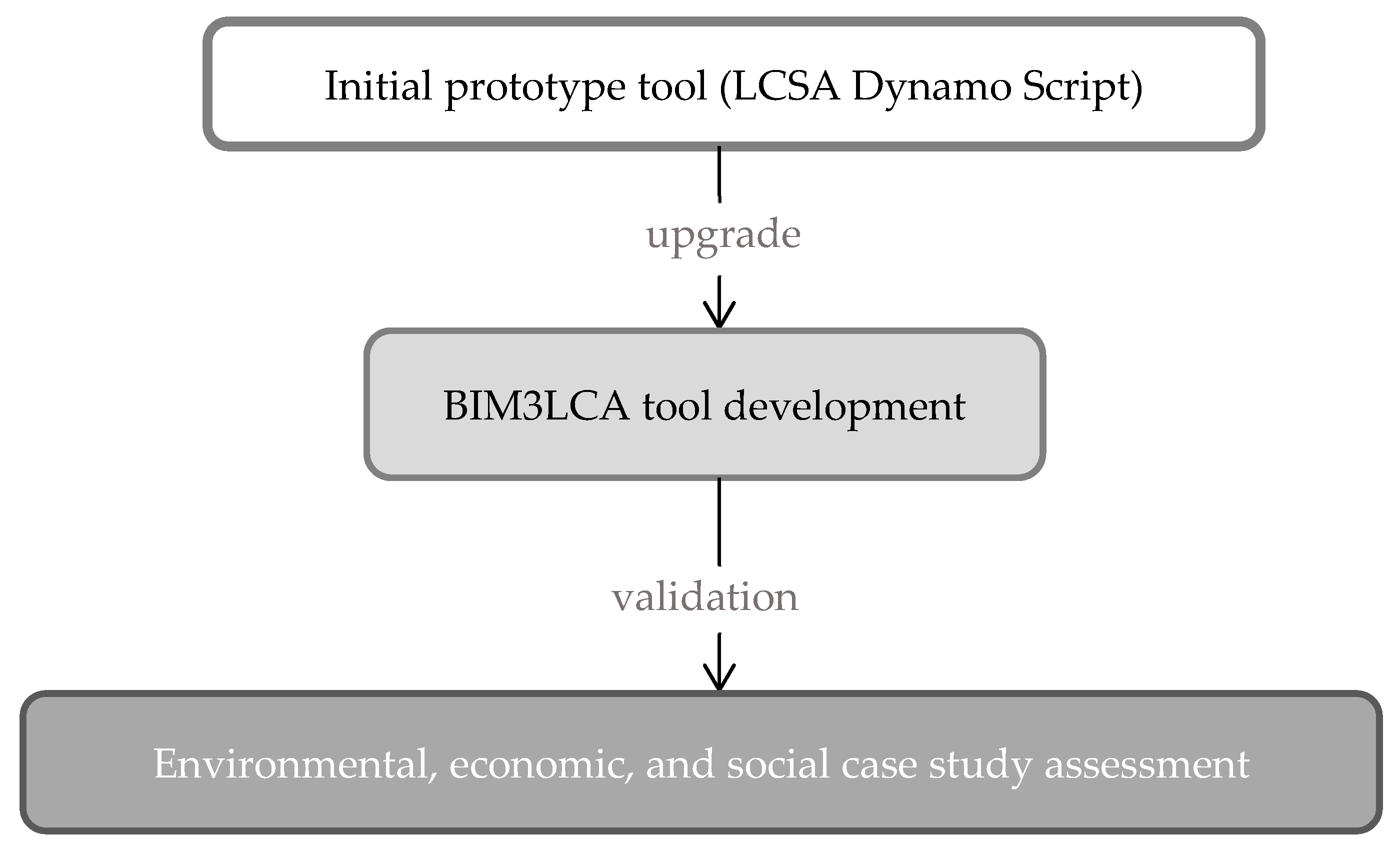

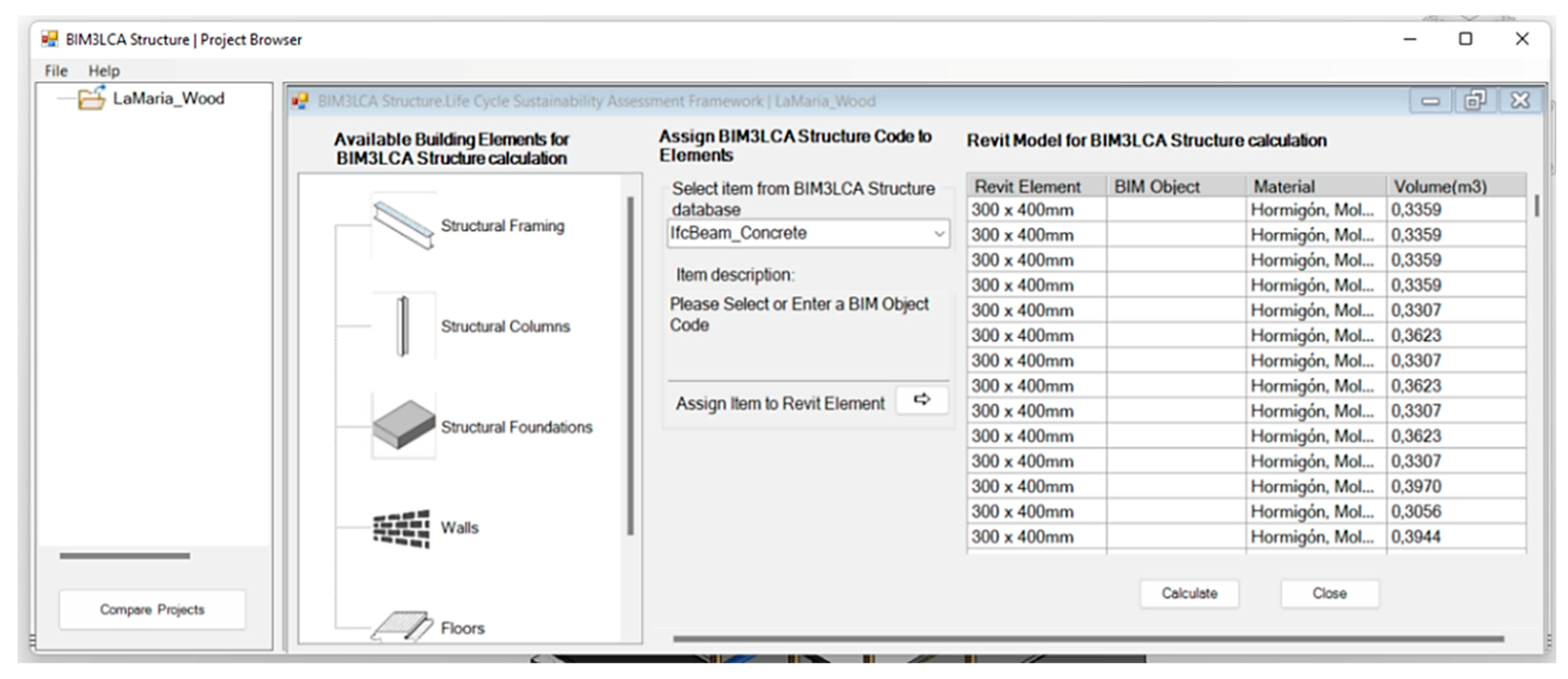
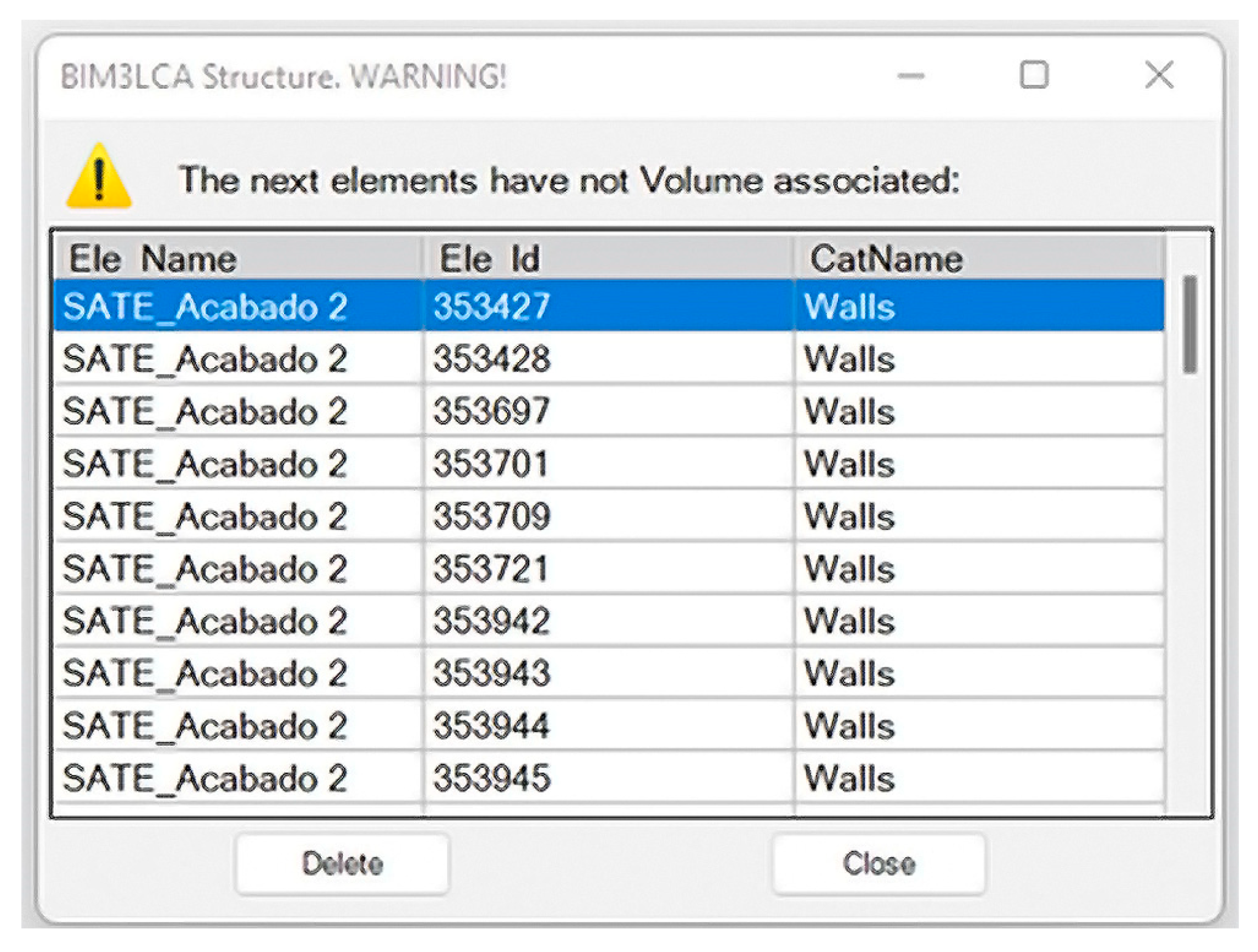


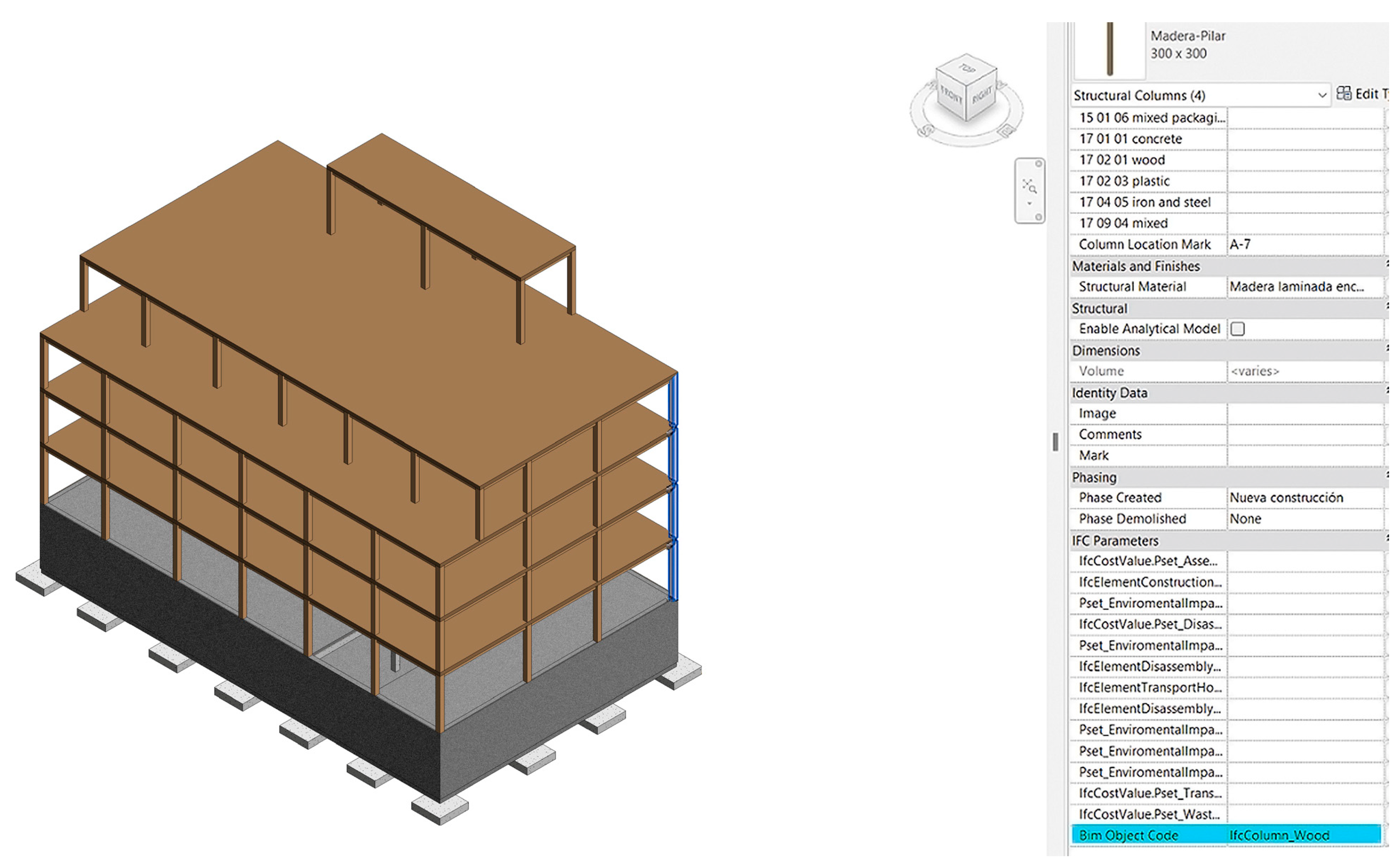
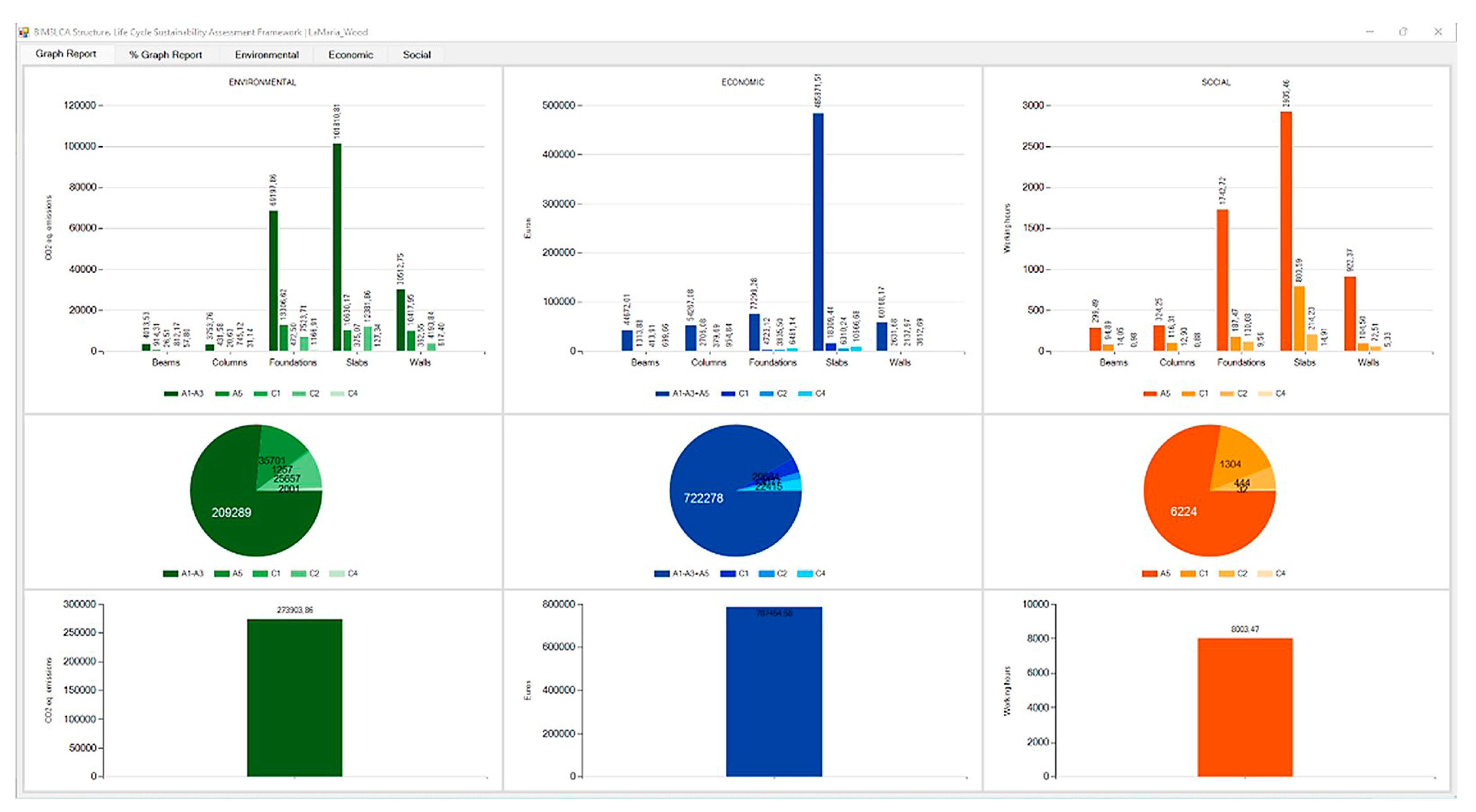
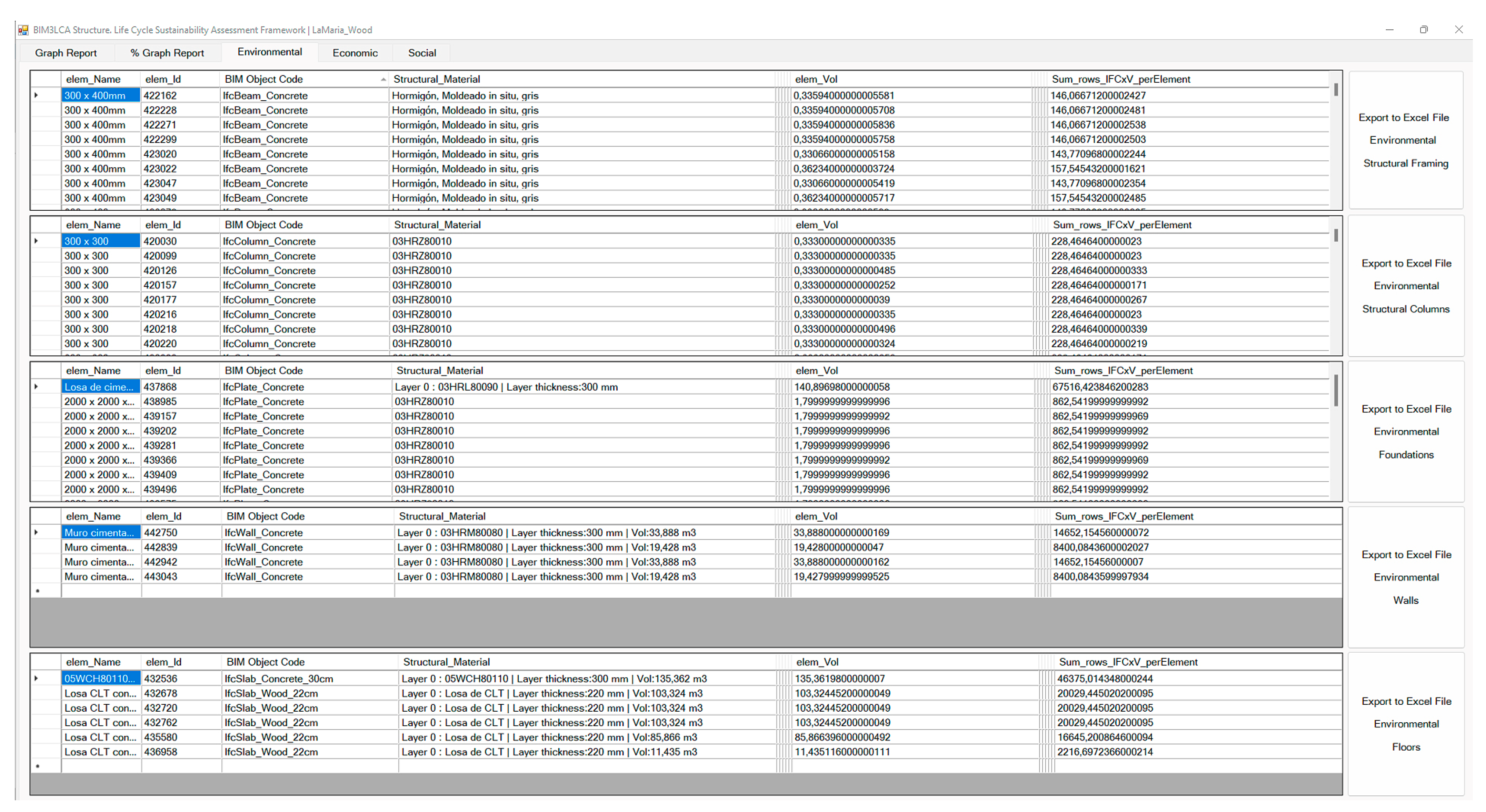


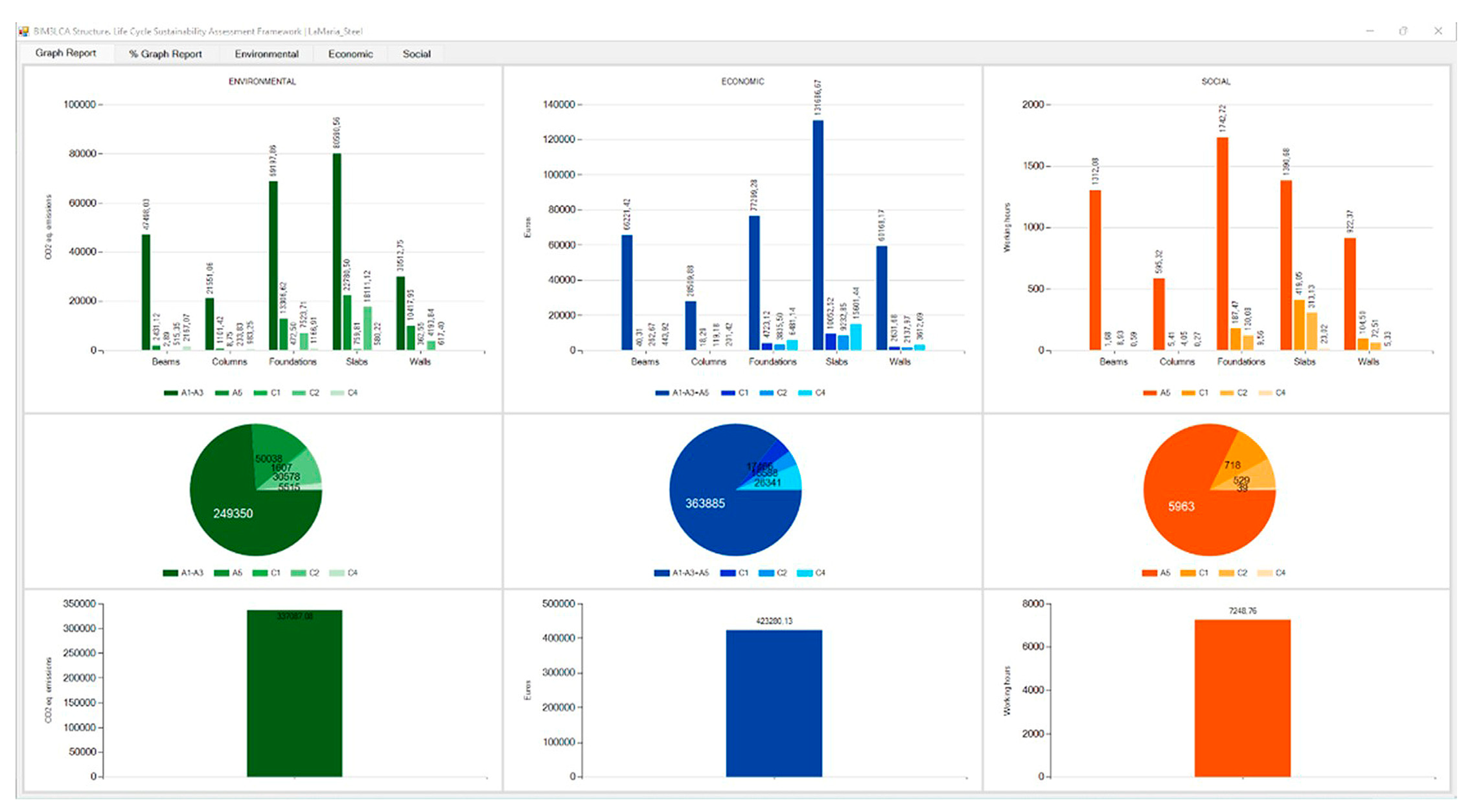
| Information Modules Building Sustainability Assessment | ||||||||||||||||||
|---|---|---|---|---|---|---|---|---|---|---|---|---|---|---|---|---|---|---|
| A0 | A1-A3 | A4 | A5 | B1 | B2 | B3 | B4 | B5 | B6 | B7 | B8 | C1 | C2 | C3 | C4 | D | ||
| Environmental LCA | E | X | X | X | X | X | ||||||||||||
| O | ||||||||||||||||||
| Economic LCC | E | X | X | X | ||||||||||||||
| O | ||||||||||||||||||
| Social S-LCA | E | X | X | X | X | |||||||||||||
| O | ||||||||||||||||||
| Data input | ||||
|---|---|---|---|---|
| LCA | LCC | S-LCA | ||
| BIM model | Building elements volumes | Building elements volumes | Building elements volumes | |
| TBL database | ||||
| Data output | ||||
| LCA | LCC | S-LCA | ||
| Impact category and indicator | CO2 eq. emissions | Euros | Working hours |
| Design Option 1 | Design Option 2 | Design Option 3 | |
|---|---|---|---|
| Foundations | Reinforced Concrete H25 | Reinforced Concrete H25 | Reinforced Concrete H25 |
| Retaining walls | Reinforced Concrete H25 | Reinforced Concrete H25 | Reinforced Concrete H25 |
| Beams | Wood M24 | Reinforced Concrete H25 | Steel |
| Columns | Wood M24 | Reinforced Concrete H25 | Steel |
| Slabs | Wood CLT | Reinforced Concrete H25 | Collaborating and (collaborating) metal sheet |
| Environmental (Kg. CO2 eq.) | Economic (Euros) | Social (Working Hours) | |
|---|---|---|---|
| Timber | 273,904 | 787,455 | 8003 |
| Concrete | 474,249 | 569,867 | 10,423 |
| Steel | 337,087 | 423,280 | 7249 |
| Design Option 1 | Design Option 2 | Design Option 3 | ||||
|---|---|---|---|---|---|---|
| Manual Extraction | Plug-In | Manual Extraction | Plug-In | Manual Extraction | Plug-In | |
| Foundations | 191.30 | 191.2970 | 291.14 | 291.1433 | 191.30 | 191.2970 |
| Retaining walls | 106.63 | 106.6320 | 163.54 | 163.5176 | 106.63 | 106.6320 |
| Beams | 35.90 | 35.9006 | 25.88 | 25.8787 | 4.19 | 4.1946 |
| Columns | 38.77 | 38.7684 | 52.14 | 52.1991 | 1.90 | 1.9032 |
| Slabs | 542.64 | 542.6368 | 633.31 | 633.3076 | 460.49 | 460.4912 |
Disclaimer/Publisher’s Note: The statements, opinions and data contained in all publications are solely those of the individual author(s) and contributor(s) and not of MDPI and/or the editor(s). MDPI and/or the editor(s) disclaim responsibility for any injury to people or property resulting from any ideas, methods, instructions or products referred to in the content. |
© 2023 by the authors. Licensee MDPI, Basel, Switzerland. This article is an open access article distributed under the terms and conditions of the Creative Commons Attribution (CC BY) license (https://creativecommons.org/licenses/by/4.0/).
Share and Cite
Soust-Verdaguer, B.; Gutiérrez Moreno, J.A.; Llatas, C. Utilization of an Automatic Tool for Building Material Selection by Integrating Life Cycle Sustainability Assessment in the Early Design Stages in BIM. Sustainability 2023, 15, 2274. https://doi.org/10.3390/su15032274
Soust-Verdaguer B, Gutiérrez Moreno JA, Llatas C. Utilization of an Automatic Tool for Building Material Selection by Integrating Life Cycle Sustainability Assessment in the Early Design Stages in BIM. Sustainability. 2023; 15(3):2274. https://doi.org/10.3390/su15032274
Chicago/Turabian StyleSoust-Verdaguer, Bernardette, José Antonio Gutiérrez Moreno, and Carmen Llatas. 2023. "Utilization of an Automatic Tool for Building Material Selection by Integrating Life Cycle Sustainability Assessment in the Early Design Stages in BIM" Sustainability 15, no. 3: 2274. https://doi.org/10.3390/su15032274
APA StyleSoust-Verdaguer, B., Gutiérrez Moreno, J. A., & Llatas, C. (2023). Utilization of an Automatic Tool for Building Material Selection by Integrating Life Cycle Sustainability Assessment in the Early Design Stages in BIM. Sustainability, 15(3), 2274. https://doi.org/10.3390/su15032274







